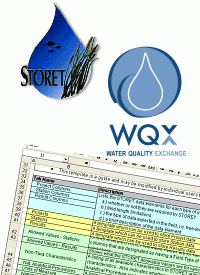Region 9 Tribal Clean Water Act Programs and Grants
Additional Resources
- Water Quality Standards Tools for Tribes
- CWA Section 106 FY2017 Solicitation Notice
- FY 2017 Section 319 Competitive Grant Request for Proposals
- EPA's Water Quality Certifications on Tribal Lands of the Pacific Southwest
- EPA Water Quality Data Tools
- Drought Planning Handbook: Emergency Drinking Water Supply for California Indian Tribes
The objective of the Clean Water Act (CWA) is to restore and maintain the chemical, physical, and biological integrity of the Nation's waters. The CWA programs support monitoring, assessment, protection, prevention of polluted runoff in waterways and wastewater infrastructure.
EPA's Region 9 Tribal Water Office manages all grants related to the Clean Water Act for over 100 federally recognized tribes within Region 9. The Tribal Water Office also provides programmatic and technical assistance for water quality standards and for the CWA grant programs.
- List of CWA Project Officers
- Past Presentations
CWA Section §106 Water Pollution Control Grants
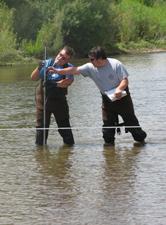 Fort McDowell Indian Tribe water quality sampling at the Verde River funded through the Clean Water Act Section 106 program.
Fort McDowell Indian Tribe water quality sampling at the Verde River funded through the Clean Water Act Section 106 program.Purpose
To assist Federally-recognized Indian Tribes develop institutional capacity to administer water quality programs and protect natural resources.
Eligible Activities (but not limited to this list)
- Performing water quality monitoring and assessments
- Carrying out activities to meet the three reporting requirements (for more information, see below)
- Develop a monitoring strategy
- Submission of data is a STORET-compatible format
- Annual Water Quality Assessment Report
- Hiring qualified staff to identify and prioritize water quality issues
- Leasing/renting office space and purchasing water quality monitoring equipment and supplies
- Developing a Nonpoint Source Assessment Report and Management Program Plan
- Conducting studies related to water pollution control
- Implementing and enforcing water pollution control measures
- Developing and implementing ground water quality monitoring programs
- Developing tribal-approved Water Quality Standards (WQS)
- Developing a 305(b) Report
- Training and travel
Funding
EPA typically awards grants between $40,000 and $200,000; first time applicants may receive grants for $40,000.
Eligibility Requirements
Contact Information
Danielle Angeles (angeles.danielle@epa.gov)
(415) 972-3441
Tiffany Eastman (eastman.tiffany@epa.gov)
(415) 795-2435
Guidance and Application Information
- Region 9 Tribal Water Section Grant Fact Sheets
- CWA Section 106 FY2017 Solicitation Notice
- CWA Section 106 Tribal Grant Guidance
- Managing the Quality of Environmental Data at EPA Region 9
Resources
CWA 106 Reporting Requirements
Managing and analyzing water quality data effectively is integral to the CWA Section 106 program. The program contains 3 reporting requirements that tribes must fulfill while implementing their water quality programs:
Follow these links to obtain detailed information about each reporting requirement.
Reporting Requirements
Contact Information
Audrey L. Johnson (Johnson.audreyl@epa.gov)
(415) 972-3431
Clean Water Act Section §319 - Nonpoint Source Pollution Control Program Grants
Purpose
The purpose of the Nonpoint Source (NPS) Pollution Control Program is to assist tribes develop and implement polluted runoff control programs that address critical water quality concerns at a watershed level.
What is NPS?
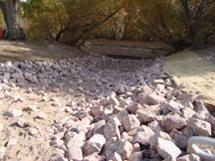 Salt River Pima Maricopa Indian Community streambank restoration and erosion control project funded through the Clean Water Act Section 319 program to reduce sedimentation by laying out rocks along the banks to hold down dirt.
Salt River Pima Maricopa Indian Community streambank restoration and erosion control project funded through the Clean Water Act Section 319 program to reduce sedimentation by laying out rocks along the banks to hold down dirt.NPS pollution - polluted runoff - occurs when rainfall, snow melt, or irrigation water runs over land or through the ground, picks up pollutants, and transports them into surface waters or ground water. Major nonpoint sources of pollution include agricultural practices; unrestricted livestock grazing; poor siting and design of roads, highways, and bridges; forestry; urban runoff; abandoned mines; construction sites; channelization of streams; and hydromodification, such as building and maintaining dams and levees.
Eligible Activities (but not limited to this list)
- Road stabilization/ removal;
- Riparian planting;
- Stream channel reconstruction;
- Low impact development projects/storm water management;
- Livestock exclusion fencing;
- Springs protection;
- Septic system rehabilitation;
- NPS ordinance development;
- Project monitoring (pre-project, during project, post-project);
- Development of a watershed-based plan;
- Training which assists the applicant in development NPS implementation projects;
- Staff time and materials towards implementing projects; and
- NPS education and outreach relevant to successful implementation of NPS projects.
Funding
- Base Funding: Funds are allocated based on tribe's land area. If a tribe has 640,000 acres or less of land, the allocation is $30,000. If a tribe has more than 640,000 acres, the allocation is $50,000.
- Competitive Funding: After all base allocations are made to tribes, the remaining amount from overall national allocation is up for competition to all eligible Tribes, regardless of land size. Tribes applying for competitive funds can request up to $150,000 of federal funding.
Eligibility Requirements
Contact Information
Audrey L. Johnson (Johnson.audreyl@epa.gov)
(415) 972-3431
Howard Kahan (kahan.howard@epa.gov)
(415) 972-3143
Guidance and Application Information
Resources
- Region 9 Tribal Water Section Grant Fact Sheets
- NPS Success Stories Booklet
- National NPS Program - EPA HQ web site (Tribal 319 Grant Program)
CWA Section §104(b)(3) - Wetlands Program Development Grants
The goals of EPA's wetland program include increasing the quantity and quality of wetlands in the U.S. by conserving and restoring wetland acreage and improving wetland condition. In pursuing these goals, EPA seeks to build the capacity of all levels of government to develop and refine effective, comprehensive programs for wetland protection and management.
Purpose
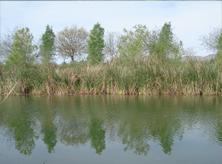
The wetlands program development grant (WPDG) provides states, tribes, local governments, interstate agencies, and inter-tribal consortia an opportunity to carry out projects to develop and refine comprehensive wetland programs. WPDGs provides eligible applicants an opportunity to conduct projects that promote the coordination and acceleration of research, investigations, experiments, training, demonstrations, surveys, and studies relating to the causes, effects, extent, prevention, reduction, and elimination of water pollution.
Funding
EPA typically awards between $50,000 to $350,000 per project grant. Funding is dependent upon amount requested and the overall size and need of the project.
Starting to think about developing a tribal wetlands program?
- Monitoring and assessment
- Regulation
- Voluntary restoration and protection
- Wetland WQS
Each of these four core elements is comprised of several broad "actions" that if collectively carried out would complete that core element. In addition, each action is made up of several more specific "activities" which are the actual steps a state/tribal/local government would carry out to achieve each option. The four core elements, the set of development or refinement activities and the specific actions under the four core elements that are eligible for funding are listed at Wetland Program Development Grant.
Further Information
The full CEF can be found at Core Elements of an Effective State and Tribal Wetlands Program Framework. Some of the activities outlined in the full CEF are not eligible for the WPDG funding. The CEF provides a menu of activities for wetland program development, regardless of whether such activities are eligible for WPDG funding.
Eligibility Requirements
There are no eligibility requirements for tribes except the tribe must be federally-recognized.
Contact Information
Leana Rosetti (rosetti.leana@epa.gov)
(415) 972-3070
Resources
- Region 9 Tribal Water Section Grant Fact Sheets
- National Wetlands Program Development Grants Website
CWA Tribal Set-Aside Program - Wastewater Infrastructure
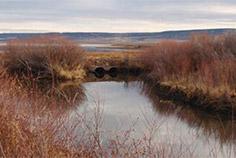
EPA utilizes the Indian Health Service (IHS) Sanitation Deficiency System (SDS) list to select projects that are eligible for funding. Tribes have an option of receiving a direct grant or receive an Interagency Agreement (IAG) with their corresponding IHS area office. EPA contacts the selected tribe directly and requires a written response on the selected option to receive funds.
Examples of Eligible Activities
- Interceptor sewers
- Wastewater Treatment Facilities (conventional or alternate)
- Infiltration/Inflow correction
- Collector sewers
- Major sewer rehabilitation
- On-site systems (e.g., septics)
Funding/Accomplishments
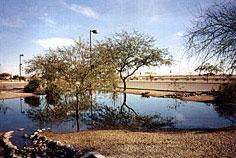 Stormwater Basin at Gila River Indian Community.
Stormwater Basin at Gila River Indian Community. As of FY 2009, the program has awarded $62 million in funds that have supported 300 wastewater projects. These projects have served about 40,000 homes in Indian Country.
Contact Information
Loretta Vanegas (vanegas.loretta@epa.gov)
(415) 972-3433
Nancy Sockabasin (sockabasin.nancy@epa.gov)
(415) 972-3772
Resources
- Region 9 Tribal Water Section Grant Fact Sheets
- Clean Water Indian Set-Aside Grant Program
- EPA Water Infrastructure and Resiliency Finance Center
Water Quality Standards
Water Quality Standards (WQS) are the foundation of the nation's surface water quality protection program. See the National EPA Water Quality Standards Web site for complete information including basic descriptions and documents for approved tribal water quality standards.
Indian Tribes can Administer the WQS Program on Tribal Land
With an approved WQS program, an Indian tribe can set the water quality goals for all surface waters (e.g., streams, rivers, lakes, and wetlands) on the reservation. The tribe will also determine whether activities which require a federal license or permit are consistent with the tribe's WQS.
How Authorization Under the Clean Water Act Benefits Indian Tribes
- Tribes establish water quality goals for reservation waters to protect water resources.
- Tribes designate uses of water bodies which may include cultural or traditional purposes
Questions About WQS Program Authorization
1. What does a Tribe need to start the WQS process for our reservation lands?
2. What is program authorization?
- The tribe must be federally recognized
- The tribe must have a governing body that carries out substantial governmental duties and powers
- The tribe must have authority to administer the program for reservation waters
- The tribe must be capable of administering an effective WQS program
Upon receiving authorization, the tribe can submit its WQS for approval to EPA. You can submit both applications for program authorization and Tribally adopted WQS at the same time.
3. How does a tribe apply for the WQS program?
Region 9 has approved 14 Tribal WQS programs:
- White Mountain Apache
- Hoopa Valley Tribe
- Hualapai Tribe
- Big Pine Band of Shoshone Paiute Indians
- Bishop Paiute
- Dry Creek Rancheria Band of Pomo Indians
- Havasupai Tribe
- Navajo Nation
- Twenty-Nine Palms Band of Mission Indians
- Pyramid Lake Paiute Tribe
- Hopi Tribe
- Walker River Paiute Tribe
- Cortina Band of Wintun Indians
- Pala Band of Mission Indians
A list of all tribes in the United States with TAS for Water Quality Standards can be found on EPA's national website.
Contact Information
(415) 972-3441

